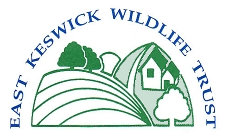This small nature reserve, open to the public, is owned by the Parish Council and managed on its behalf by the East Keswick Wildlife Trust. The footpath is permissive and not a right of way.
History
This nature reserve was part of two fields in private ownership until the 1980s when it was bought by a building company who obtained planning permission to build houses in Keswick Grange and Church Drive. As part of the planning agreement, this lower area of land, subject to flooding from the Keswick Beck, was bequeathed to the Parish Council as public open space. The Trust recognised its significance as an important site of natural history interest in the parish and in 1995 signed a Management Agreement with the Parish Council to manage the land for the benefit of its flora and fauna.
Flora and Fauna
Grazed as a pasture until the 1980s, this small pocket of land had not been intensively cultivated, drained or improved, which would have resulted in the loss of its native flora and fauna. The reserve still retains plants and animals once common in similar habitats in the parish and surrounding countryside but now becoming locally, regionally and nationally scarce. The damp conditions and high water table result in a wetland community of plants and animals.
Some of the plants that can be found are; Marsh Marigold, Valerian, Common Bistort, Water Figwort, Meadowsweet, Gypsywort, Water Mint, Great Burnet, Angelica, Lady’s Smock and Ragged Robin.
It is a rich habitat for birds, mammals, amphibians and insects. Breeding birds include Tree Creeper, Bullfinch and Great Spotted Woodpecker, whilst in summer many species of butterfly can be seen such as Orange-tip, Speckled Wood, Small and Large Skippers, Holly Blue, Meadow Brown, Ringlet and Gatekeeper.
Frogs live and breed here. Two rare snails; Aplexa hypnorum and Oxychilus helveticus. have been recorded. These freshwater snails are now becoming rare due to loss of suitable habitat nationally. In summer dragonflies and damselflies may be seen around the ponds and the large Mayfly, Ephemera danica, along the stream.
The damp and wet soil conditions favour tree species such as a Crack Willow, Bay Willow, Pussy Willow and Alder. There are also some large English Oaks Quercus robur.
Management
The Trust manages the site to retain a balance between wet grassland, open marsh, scrub and woodland. Our aim is to conserve the numerous species of plants and animals associated with a wet marshland, of which the prevalent Marsh Marigold, Meadowsweet and the many species of sedge and rush are so characteristic. Hazel has been coppiced, ponds dug and hedges laid in the traditional manner. In recent years, Trust members and volunteers have been removing the non-native Himalayan Balsam which was starting to dominate large areas of the reserve, shading out the native flora.
The reserve is fragile, please take care of it.
- Keep your dog on a lead
- Cycling prohibited
- No unauthorised camping or fires
- Please take your litter home
- We welcome your support in helping us to look after the reserve.
- You are reminded that you take responsibility for your own safety whilst on this Reserve.
- Be aware that paths and steps may be slippery and affected by debris. This site contains both still and running water. found on our volunteering page
- We would welcome any natural history records for our data base.

